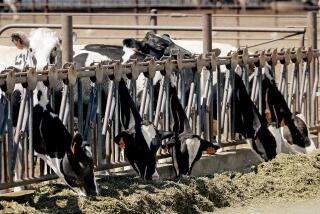Water Beds for Cattle? These Cows Milk It for All It’s Worth
- Share via
It’s a beautiful end-of-summer day on George te Velde’s sprawling dairy farm in Escalon in California’s Central Valley. Fresh from milking, a small herd of Te Velde’s cows is making its way back to the stalls. One large Holstein heads for a water bed and happily lies down. She adjusts, moving more on her side, tucking her feet under to get situated just right. Ah, she seems to say, that’s perfect, as she floats comfortably and begins chewing her cud.
George te Velde, a third-generation dairyman, bought 182 water beds about a year ago as an experiment. He still has to keep big hills of almond shells and dried manure on his property for the rest of his 2,300 stalls. He has 2,500 cows. “You have to keep their beds level, without holes or pits,” he said, “because cows don’t like lumpy beds any more than people do.” But, as cows lie on their beds all day, they make indentations, so the beds constantly have to be raked flat. With the water beds, he said, there are no lumps and no need for raking.
Te Velde said he was amazed during a recent heat wave that the cows that had water beds were so comfortable they stayed on them, instead of going out into the corral as the rest of the herd did.
A dairy cow should spend a lot of its day lying down, at least five to six hours after every meal, to ruminate well. If you’re a dairy farmer, the last thing you want to see is your cows standing around too long, Te Velde said. Standing cows are not happy cows. If they’re forced to stand because their beds aren’t comfortable, they become stressed. Cows don’t handle stress well. They lose weight, get sore feet and produce less milk. “The cow is very complicated. If they’re not happy, their attention is going to aggravation, not milk production,” said Gerard Niessink, Western sales representative of GNE Farm Equipment, which makes cow water beds.
About 30,000 cow water beds have been sold in America in the last four years, since they were introduced from England. There are 4,000 in California, where dairy farmers report that when cows have a choice of sleeping arrangements, they will push each other out of the way to get to the water beds.
Minnesotan Al Peters was one of the first American dairymen to purchase water beds for his cows. Peters said cows are like people. He regards a few of his 150 cows as companions with whom he can converse. Peters said cow comfort is all cows talk about. “If a cow stands in the walkway and she doesn’t lay down a lot, she’s telling you that her stall is not comfy.”
Peters’ cows took a week to get used to the first 18 water beds he installed. Then they filled up and haven’t been empty since. “The first year we had them, the cows were standing behind each other trying to go lay down on them,” he said. Peters now has 104 water beds, each expected to have a 10- to 15-year lifespan. He said the only maintenance is adding antifreeze or windshield-wiper fluid to keep them from freezing in the Minnesota winter.
Before Peters bought his first water beds, he tried a flat mattress, but in five years it got hard as a rock, he said.
“You know, if me and you laid out on the highway every night, we wouldn’t wake up feeling too peppy. It’s the same way with cows,” he said.
For the softest cow bedding, dairymen traditionally have used composted manure, straw, sawdust, shells, sand or a combination. Besides requiring a lot of maintenance, conventional bedding, if it gets wet or hard from use, can cause health problems for the cows, such as mastitis.
Cows that lie on hard surfaces can develop sores on their elbows the size of baseballs. “If you ever watch a cow lay down, they don’t actually lay down, they fall down,” said Dinuba, Calif., dairyman Gerrit Griffioen. “Basically, the easy way to tell if your beds are soft enough is if you fall down on it on your knees and it doesn’t hurt your knees, then it’s not too hard and it’s not going to hurt your cow.”
Griffioen goes out of his way to make sure his cows are comfortable. In the summer, if it’s over 80 degrees, he runs fans and misting sprinklers to keep them cool. Griffioen doesn’t have any water beds yet, but he thinks it’s a good idea. “Water beds around here are a pretty new thing, and they are pretty expensive, but bedding adds up too. If this water bed thing proves itself, it’ll take off,” he said.
Water beds for cows were designed 10 years ago by British aviation tycoon Alan Bristow. Bristow was looking for a better bed for his own herd of 400 cows in Surrey, England, and a replacement for the rubber mattresses he’d tried, which had become hard. The thought came to him that by putting water in the beds it would be like making them into big hot water bottles. His cow water beds are now being used by farmers in many parts of Europe.
Bovine water beds don’t look exactly the same as human water beds. Because cows walk on them, and need to feel sure-footed, the beds are slimmer, with about 17 gallons of water in each pad -- compared to 80 gallons for a deep, queen-sized, human water bed.
The cost of a cow water bed is about $200, which includes a concrete base to hold the mattress. At Mr. Waterbed in Fullerton, owner Mike Abbot said prices are about $200 more for a human water bed. He wasn’t surprised that cows like water beds.
Nor was Abbot surprised that they’re holding up under cows. He had an elephant get on one once, he said. It was a big one and it rolled around on the bed for a while. He said everyone watching thought the elephant was going to break the water bed, but there were just a few holes in it from its nails.
“I’ve been telling large-sized customers, complaining that the beds won’t be big enough for them, that they can hold an elephant,” Abbot said. “And now I’m going to add that cows are sleeping on them.”
More to Read
Sign up for Essential California
The most important California stories and recommendations in your inbox every morning.
You may occasionally receive promotional content from the Los Angeles Times.













